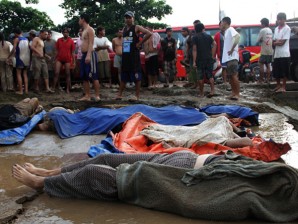Flood-hit Philippine cities prepare mass burials
ILIGAN CITY, Philippines—The Philippines set up mass burial sites Monday for decomposing bodies of flood victims after a cyclone disaster left an estimated 700 people dead on the southern island of Mindanao.
Officials in the port cities of Cagayan de Oro and Iligan, where sleeping families were swept to sea from coastal slums, said unclaimed cadavers piling up in mortuaries were posing health risks and had to be interred.
Burials were expected to take place starting Tuesday.
The Philippine Red Cross set the death toll from Saturday’s flash floods spawned by tropical storm Sendong (international name: Washi) at 713 while the government’s disaster council put the figure at 662 with 82 still missing late Monday.
Most of the dead were from the two cities, which were built around river systems that overflowed when a month’s worth of rain fell in a 24-hour period.
Article continues after this advertisementThe disaster area, located about 800 kilometers (500 miles) from the capital Manila, is normally bypassed by typhoons that ravage other parts of the far-flung Philippine archipelago every year.
Article continues after this advertisementTeresita Badiang, an engineer at the Iligan mayor’s office, said the city had begun constructing two concrete communal tombs where cadavers would be placed side by side “so that their burial will be dignified.”
The disaster council said at least 227 people died in Iligan.
Television footage from an Iligan mortuary showed a corridor lined with bodies wrapped in white plastic bags bound with tan-colored packaging tape.
In Cagayan de Oro, where the disaster council placed the death toll at 336, Mayor Vicente Emano said a mass burial would be held within the week.
Dr. Jaime Bernadas, the department of health’s director for the region, said cadavers were still being processed prior to “temporary burial” in the city.
Health officials were taking DNA samples and photographs of victims.
“We are giving time for relatives to claim (the bodies),” he told AFP by telephone.
About 47,000 evacuees are now huddled in evacuation centers in Sendongi’s wake, mostly in the northern coast of Mindanao, a vast poverty-stricken island troubled for decades by a Muslim separatist insurgency.
Dr. Eric Tayag, head of the national epidemiology center in Manila, said the government was taking steps to prevent outbreaks of cholera, dysentery, dengue and respiratory problems particularly in congested evacuation centres.
“Around 10 days after this flooding there might be an epidemic of water-borne diseases,” Tayag warned on television.
Philippine Red Cross chief Gwendolyn Pang said strict guidelines had to be followed in mass burials, including photographing corpses, listing identifying marks and laying them a meter apart for possible exhumation.
“I’m sure their families will look for them,” she told AFP.
President Benigno Aquino is set to visit the stricken zone on Tuesday after ordering a review of the country’s disaster defenses.
Benito Ramos, the disaster council chief, said most of the victims were “informal settlers” – a term typically used for slum squatters and internal migrants who are often unregistered by authorities.
The Philippine Red Cross still had more than 500 people classified as missing late Monday, down sharply from more than 900 earlier in the day, and officials expect this to fall after further verification.
Authorities likened the impact of tropical storm Sendong to Ondoy (international name: Ketsana), one of the country’s most devastating storms, which dumped huge amounts of rain on Manila and other parts of the country in 2009, killing more than 460 people.
Originally posted: 10:12 am | Monday, December 19th, 2011
